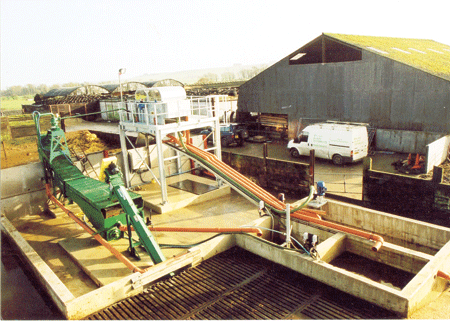New system takes sand out of slurry

Shovelling sand is an activity that slurry handling expert Peter Russell believes should be confined to building sites or the beach. Yet producers using the material to bed cow cubicles need rather more substantial equipment than a bucket and spade to shift the sand that accumulates in slurry lagoons and dirty water settlement tanks.
“Sand is a great material for cubicle bedding and judging by the various devices that are available quite a bit of thought has been given to spreading it easily and evenly,” he points out. “But little thought is given to dealing with the sand that gets flushed or scraped away from the cubicle house, other than to call in a 360° excavator every couple of years to dig it out of the lagoon.”
His solution is a separation and washing process claimed to recover most of the sand lost in this way and to clean it sufficiently well for it to be reused. The key to the system, he reckons, is to know when to keep the sand and slurry as a homogenous mix and when to dilute it so that the sand falls out.
“Imagine half filling a bucket with a mixture of slurry and sand – some of the sand will fall to the bottom but not much,” he points out. “But top it up with water and swish it around and you’ll soon end up with virtually all the sand lining the bottom of the bucket.”

The recovery and washing system developed by Mr Russell’s Warwickshire-based Midland Slurry Systems works on this principle by keeping effluent as a thick material to hold the sand in suspension. Parlour washings and yard run-off are channelled elsewhere to keep the effluent glutinous and liquid is added only when it is time for the sand to come out.
“Sand-laden effluent is pushed into a reception pit where an auger lifts it to the separation and washing unit, which is also in the form of an inclined auger,” Mr Russell explains. “Water is pumped into the bottom end of this auger to dilute the effluent and a little compressed air injected to agitate it. The sand falls to the bottom and is carried away by the auger flights, while the liquid and fibre cascade over a weir.”
A light water spray trickle-cleans the sand as it continues along the auger before it is discharged to a pile where it is left to drain. The dilute effluent, which still contains some fine sand particles, is pumped from a well beneath the separation auger to a cyclone positioned overhead.
“This takes out the last of the sand, which falls into the separation auger,” explains Mr Russell. “Ideally, the effluent is then passed over a solids separator. Some of the liquid can then be used for the dilution process to minimise the amount of fresh water involved.”
At about £78,000 for an installation to go with an existing solids separator (setting-up from scratch will be about £150,000), Mr Russell calculates the savings in sand costs alone will see the system pay for itself in just a few years.
“A 320-cow herd will use 1000t of sand a year at a cost of £15,000 for material of the ideal grade and condition for bedding,” he says. “Based on 85% sand recovery, the system will pay for itself in about six years.”
Although farmers using similar systems in North America use the recovered sand pretty much immediately, the Wiltshire dairy unit using the first installation is holding off for two to three months until the results of long-term pathogen testing and monitoring have been assessed.
“Unlike sand recovered from settlement tanks, the washed material from our process can be reused,” Mr Russell emphasises. “But while the sand itself is inert, there is some fibrous material such as whole maize grains retained during the process, so we’re being cautious at this stage about how soon after recovery the sand should go back into the cubicles.”

